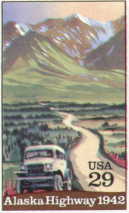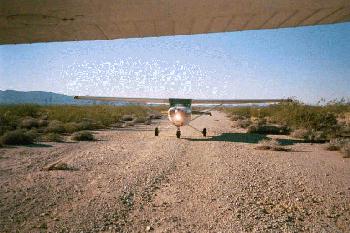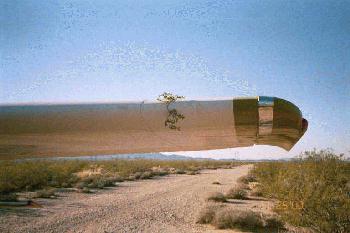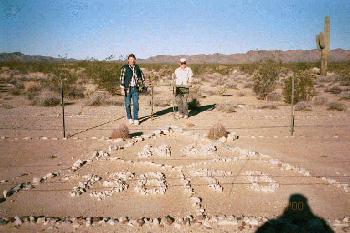
Home
Aviation Stories
"In Memory Of"
Net Sites
Sign Guestbook
View Guestbook
Email Ron
Sell your Trust Deed

Hil-Pat Airfield (aka Camp Bouse), Arizona OutbackBy Ron Kilber
Pictures by Den PeckSaturday, November 25, 2000
An Indian Hills Airpark Great Flapjack Cookout
Almost sixty years ago, the desert below me was used by the US Army to help train more than one-million troops for WWII warfare in Africa, Europe and the Pacific. Today, the land isn't used for much of anything. Pretty much unchanged since WWII, it's available for public recreation for anyone with the means and wit to get here.
Camp Bouse is situated in Butler Valley, which stretches ten miles wide by thirty miles long, bounded on the north by the Buckskin Mountains and on the south by the Harcuvar Mountains. Bouse lies twenty or so miles west. Cunningham Wash is adjacent to the camp.
Camp Bouse was one of eleven outposts of the Desert Training Center (DTC), which was built under the command of General George C. Patton, Jr. in 1942. The DTC encompassed more than 18,000 square miles, stretching from Searchlight, Nevada to the Mexican border and Indio, California to Aguila, Arizona.
Camp Bouse during WWII had no landing strip, however, the best of many gravel roads -- well preserved since WWII -- serves as a boondock airport for us now.
I'm on short final for Road 35 using 30 degrees of Cessna-150 flaps, negotiating a steep approach to clear high-tension power lines below me. Already on the ground are Den "Aeronca" Peck and Red "C-150" Selover.
There's only about 2,000 feet of usable landing distance on what is otherwise a mile-long road. The power lines at the south end and a sandy wash midway limit full use of what was a thoroughfare in a 600-plus acre outpost during WWII. If it were not for the fact that Peck and Selover are confined by desert vegetation on the runway's north end, I might use full flaps (40 degrees). As it is, I've a better chance to go around with only 30-degrees of flaps if need be.

What used to be the main road during WWII is now Hil-Pat Airfield.Touchdown is smooth on what turns out to be quite a nice improved gravel road. Incredibly, some of the creosote bushes along side the landing area are six-feet tall and higher. I feel like I'm landing in a narrow hallway, sometimes unable to avoid nicking the top of a creosote bush with a wing. Obviously, the plentiful rains, which not only caused the recent Wenden flood but lush new vegetation growth everywhere in the Outback desert.
After I kill the engine, I know that Peck is amused by the remnants of a creosote bush hanging from my left wing, promptly producing his camera to take a picture of it.

Creosote bush on Ron's Wing.In fact, no airplane has escaped "green wing" today. None of us regrets landing here. We're able to amuse each other because no damage has resulted from pruning the creosote bushes here at Hil-Pat.

Red Selover -- happy to be here.Hil-Pat Airfield was named by Iowa hailee, Dennis Hildreth, who fell in love with the Sonoran desert on the day he arrived some five years ago. Thus, Hil-Pat -- "Hil" for Hildreth and "Pat" for Patton. It was "love at first sight", and since then Hildreth has pruned more creosote bushes with wing shears than anyone else living in the Arizona Outback.
History of Camp Bouse
Camp Bouse was a top-secret base during WWII, used by the Ninth Tank Group for American participation in the British developed Canal Defense Light (CDL). It was believed that the CDL project would catch the Germans by surprise -- in defense of the Suez Canal -- by blinding enemy tanks with strobe-like, powerful lights mounted on Allied tanks. It was a weapon system "to change the course of the war", according to the British. So guarded was the project that security and secrecy became a way of life at Camp Bouse. Transfers were prohibited and all mail was censored. It was only possible for enlistees to leave Camp Bouse in groups of five with a sergeant in charge.

A monument in memory of the 736th Tank Battalion
Kilber & Selover -- and Peck's shadow in the foreground.Because Camp Bouse was so secret, it had to be self-contained. While there's little evidence left today, there once was a hospital, a surgical clinic, an 18,000 square-foot tank maintenance facility with concrete floor, a well and hundreds of pads for tents.
While we hike here and there -- careful to avoid jumping cacti, rattlesnakes, scorpions, gila monsters and tarantulas -- Bob "RV-6" Bumgardner overflies our position. He wanted to join us today, too, but thought better of the idea considering he has a low-wing airplane. While we only pruned the creosote bushes, Bumgardner would dug them up if he landed.
Kilber, caught by camera-surprise.
After an hour of hiking and exploring, we're all flapjack-hungry and ready to prepare some campground vittles. John "Glasair" Hong buzzes our position. Like Bumgardner, he judges correctly to avoid landing here with his low-wing Glasair.
How to cook the best flapjacks in the world
As I'm writing of campground cooking, I may as well describe how to cook the best flapjacks on earth. Close attention must be paid to a few details.
First, like hotdogs are best at the ballpark, flapjacks are best when camping. Nothing in the world quite warms the heart like hot cakes and coffee on a cold morning in a beautifully serene setting outdoors, such as we have at Camp Bouse today.
Make-shift camps can never compete with the convenience of the modern kitchen. So it's important to dispense with everything but the basics. All that's needed are a non-stick, six-inch skillet and pancake mix requiring water only.
Before mixing, place the skillet on the fire, making sure there's coffee to sip while cooking. While the pan heats, prepare the mix in a large disposable container (for easier clean-up). Pour the batter into the ungreased skillet so as to make one big cake, which is not only thick but covers the entire pan. A single flapjack made in this fashion is far more filling than several smaller ones made at once in a much larger fry pan. In fact, it's rare when someone can eat more than two of these filling, all-American breakfast favorites.
When generous bubbles form, flip the flapjack with just the motion of the skillet handle (for entertainment) or optional spatula (for extra clean-up).
Once fully cooked, the flapjack will be sufficiently firm to not only eat by hand like pizza, but it will nicely accommodate butter and syrup, as well. Plates, silverware and tables are optional, unless one's a masochist for extra work and extra clean-up.
As long as the pan is kept sufficiently hot, every flapjack will be fully cooked before anyone can devour the previous one. And by using multiple skillets, any weekend camper can make flapjacks faster than devoured by everyone who is cold and hungry in camp.
Coming Home
Take-off from Hil-Pat is without incidence. I'm first off. While I circle, Selover is next. Bringing up the back door is Peck.
As we climb home to clear the mountains, I'm amused by what once was a massive tank firing range on the north side of the Harcuvar Mountains. I anticipate the day affording me the opportunity to explore on foot the tank-shell area below us.
We all land safely at the Indian Hills Airpark.
What an adventure!
###
Copyright (C) 2000 Ron Kilber rpknet@aztec.asu.edu RonKilber.tripod.com Non-commercial reproduction permitted in its entirety with this copyright notice intact.
8:49PM 12/4/00